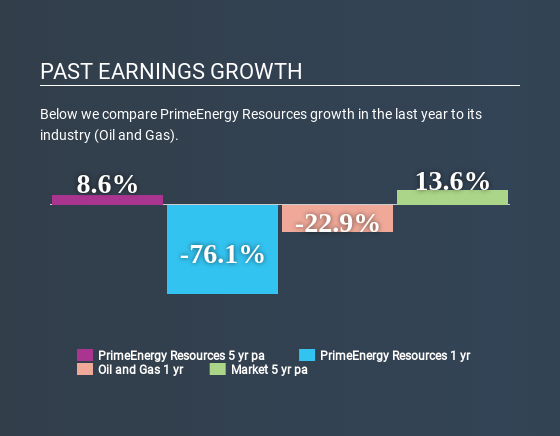Has PrimeEnergy Resources Corporation's (NASDAQ:PNRG) Impressive Stock Performance Got Anything to Do With Its Fundamentals?

PrimeEnergy Resources (NASDAQ:PNRG) has had a great run on the share market with its stock up by a significant 47% over the last month. Given that stock prices are usually aligned with a company's financial performance in the long-term, we decided to study its financial indicators more closely to see if they had a hand to play in the recent price move. In this article, we decided to focus on PrimeEnergy Resources' ROE.
Return on equity or ROE is a key measure used to assess how efficiently a company's management is utilizing the company's capital. In short, ROE shows the profit each dollar generates with respect to its shareholder investments.
View our latest analysis for PrimeEnergy Resources
How Do You Calculate Return On Equity?
Return on equity can be calculated by using the formula:
Return on Equity = Net Profit (from continuing operations) ÷ Shareholders' Equity
So, based on the above formula, the ROE for PrimeEnergy Resources is:
3.5% = US$3.7m ÷ US$103m (Based on the trailing twelve months to December 2019).
The 'return' is the profit over the last twelve months. So, this means that for every $1 of its shareholder's investments, the company generates a profit of $0.04.
What Has ROE Got To Do With Earnings Growth?
Thus far, we have learnt that ROE measures how efficiently a company is generating its profits. Based on how much of its profits the company chooses to reinvest or "retain", we are then able to evaluate a company's future ability to generate profits. Generally speaking, other things being equal, firms with a high return on equity and profit retention, have a higher growth rate than firms that don’t share these attributes.
PrimeEnergy Resources' Earnings Growth And 3.5% ROE
It is hard to argue that PrimeEnergy Resources' ROE is much good in and of itself. Even compared to the average industry ROE of 10%, the company's ROE is quite dismal. However, the moderate 8.6% net income growth seen by PrimeEnergy Resources over the past five years is definitely a positive. We believe that there might be other aspects that are positively influencing the company's earnings growth. Such as - high earnings retention or an efficient management in place.
As a next step, we compared PrimeEnergy Resources' net income growth with the industry and were disappointed to see that the company's growth is lower than the industry average growth of 26% in the same period.
Earnings growth is a huge factor in stock valuation. It’s important for an investor to know whether the market has priced in the company's expected earnings growth (or decline). Doing so will help them establish if the stock's future looks promising or ominous. If you're wondering about PrimeEnergy Resources''s valuation, check out this gauge of its price-to-earnings ratio, as compared to its industry.
Is PrimeEnergy Resources Using Its Retained Earnings Effectively?
PrimeEnergy Resources doesn't pay any dividend currently which essentially means that it has been reinvesting all of its profits into the business. This definitely contributes to the decent earnings growth number that we discussed above.
Summary
On the whole, we do feel that PrimeEnergy Resources has some positive attributes. Namely, its respectable earnings growth, which it achieved due to it retaining most of its profits. However, given the low ROE, investors may not be benefitting from all that reinvestment after all. While we won't completely dismiss the company, what we would do, is try to ascertain how risky the business is to make a more informed decision around the company. To know the 4 risks we have identified for PrimeEnergy Resources visit our risks dashboard for free.
Love or hate this article? Concerned about the content? Get in touch with us directly. Alternatively, email editorial-team@simplywallst.com.
This article by Simply Wall St is general in nature. It does not constitute a recommendation to buy or sell any stock, and does not take account of your objectives, or your financial situation. We aim to bring you long-term focused analysis driven by fundamental data. Note that our analysis may not factor in the latest price-sensitive company announcements or qualitative material. Simply Wall St has no position in any stocks mentioned. Thank you for reading.

